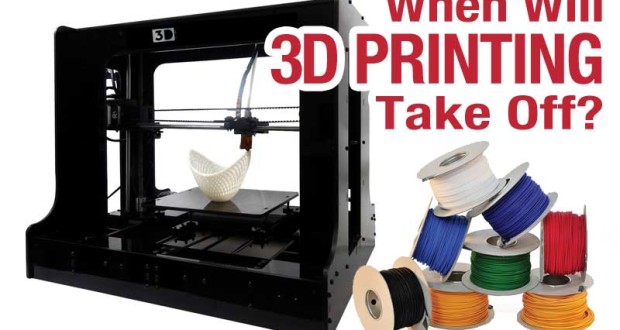3D printing is exciting. It’s a technology that’s emerging and rife with potential. It’s also, like many new technologies, starting its life in limited fashion and with adoption rates that aren’t exactly causing the mainstream consumer to take notice—at least not yet. So what’s holding back this new technology and when will 3D printing take off and go mainstream? We think there are 5 things that need to take place before this will truly be possible. Some of these items listed have begun already while others have yet to materialize. We’d welcome your comments below—particularly if you disagree.
1. 3D Printing Will Have to Become Practical and Mainstream
New technologies are hyped up and then crash when they don’t materialize. Companies such as MakerBot, however, are bringing 3D printers to market in practical packages that are really taking the technology to a more usable level with consumers. This first point is rather vague in the sense that there are a LOT of things that need to take place for 3D printing to become mainstream and practical, and those things are often interconnected. The big picture, however, is that there are two potential outlets—and neither is mutually exclusive: consumer and commercial. For the consumer side, Joe user needs to be able to access models for low cost and print them for low cost. He also needs the ability to scan and replicate items in his home for using the printer to do quick repairs when needed. For the commercial user the role of the 3D printer is almost limitless. The cost and practicality, however, needs to exceed that of the typical C&C and mold processes in use today.
2. There Needs to Be a Vast Variety of Accessible 3D Models
We don’t need a revolution of new hardware only. Consumers need access to a whole host of 3D models that are practical and tested and work with these new printers. So far, 3D models seem to range from the impractical to the trendy. Very few resources, however, exist for those who simply need access to create a new plastic part for their dishwasher, or a replacement piece for their vehicle. If you want a dragon, fake movie prop, or a anime superhero, however, the selection seems endless. 3D printing will not go mainstream until there are a host of practical models ready and available to consumers for repairs and practical purposes.
3. Cost of Materials Needs to Drop Dramatically
3D printing uses various plastics, usually in the form of filaments or wire that is pulled through the machine as needed. The source spools look a bit like giant bundles of string trimmer line. These materials include PLA (polylactic acid), ABS (acrylonitrile butadiene styrene), and other rigid, flexible and dissolvable materials.These materials, however, often cost in the neighborhood of $50 per kilogram. That price needs to drop significantly in order for casual use of the 3D printer to become something you see as often as you now see inkjet and laser printers in the home.
4. 3D Printing Speed Needs to Increase
The time it takes to print a model on a 3D printer is fast compared to shipping, but slow compared to the speeds consumers often expect. While speed isn’t the top factor in preventing 3D printing from taking off, it’s definitely one thing that, when combined with cost, prevents the technology from spreading as quickly as it might. In particular, slow print speeds affect a user’s ability to experiment with 3D models—testing to be sure a piece works and then making adjustments and reprinting as necessary. Because 3D printing is both slow and expensive, experimentation isn’t at the levels you’d want to see for an explosive new format. And it’s not all the printers’ fault. Most consumer grade printers use a technique called fused deposition modeling whereby layers upon layers of material are deposited and added to a model over time through the use of a print head. Another less common method uses laser to solidify an object out of a bath of liquid photopolymer resin. Commercial-scale 3D printers tend to use something called selective laser sintering whereby a laser actually hardens powered metal into a solid. In either case, current 3D printer speed is measured in millimeters per second (often in the range of 25-100). That speed really needs to improve over time and experiments are already in process to achieve better and faster results.
5. Color and Material Options Need to Improve
Just like the earliest printers, monochromatic printing seems to be the case with respect to 3D printers. When you do get multiple colors, the technology to put them together doesn’t appear (yet) to be additive, but rather “proximity-based” where colors exist near each other. Just as 2D printers evolved in their design to produce color printing and high resolution graphic capabilities, 3D printers must also adapt so that both color and materials can more easily be achieved. Currently, most 3D printed models have a very bland, homogenous look to them which doesn’t lend itself well to the thought of 3D printers becoming a staple in people’s homes. For that to happen, 3D printers need to take over a function typically reserved for shipping and ordering parts, toys, or other household items. What the 2D printer did for the home (empowering consumers to handle small jobs themselves but still reserving the larger print houses for major work) is what also needs to take place in the realm of 3D. Currently, 3D printers can use dozens of materials (not all at once), but manufacturers have access to literally thousands of materials for manufacturing products. When that gap narrows we’ll see even more excitement in the consumer and professional industry.
When Will 3D Printing Take Off ?
Can 3D printing move its way quickly into the consumer and professional market? We think so. While 3D printing has been around since the 1980’s, it has seen tremendous growth in just the past 5 years. Companies like Makerbot Industries, LLC are really making inroads onto the market, but companies like HP, known for their in-house innovation and manufacturing techniques, have yet to release a single model publicly. So when will 3D printing take off and go mainstream? Hopefully soon. But until the five items above happen in greater form, 3D printing will be, and remain, in a state of infancy.
 CopierGuide Copier and Multifunction Printer Leases and Reviews
CopierGuide Copier and Multifunction Printer Leases and Reviews





